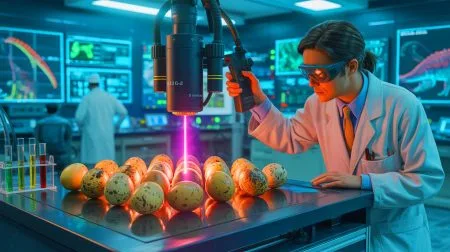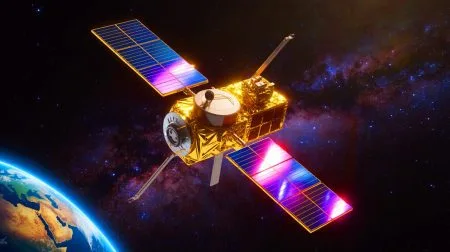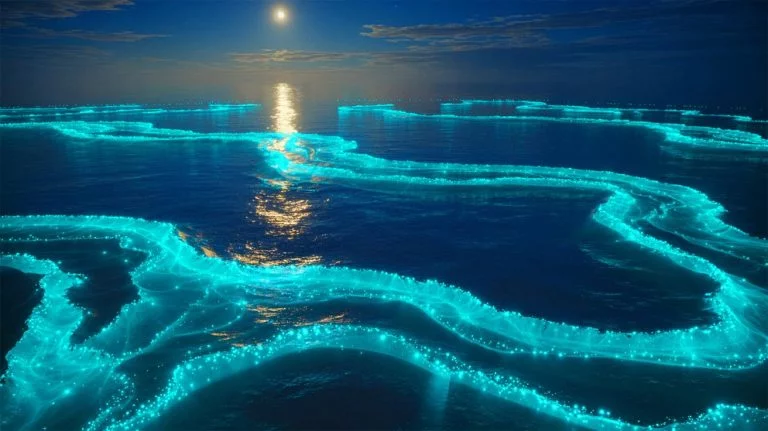| IN A NUTSHELL |
|
The recent discovery of a strange turquoise glow off the southern coast of Australia has captured the world’s attention. This bioluminescent spectacle, visible from space, was detected by NASA satellites in the waters of the Great Australian Bight and Tasman Sea. This event, known as a phytoplankton bloom, serves as a reminder of the intricate and often stunning processes that occur within our oceans. These glowing marine organisms not only create breathtaking visuals but also play a crucial role in maintaining the health of marine ecosystems.
Phytoplankton Glow Captured From Space
The bioluminescent glow observed off the coast of Australia was first documented by NASA’s PACE spacecraft. Using the advanced Ocean Color Instrument (OCI), scientists captured images of the vibrant glow illuminating the waters between mainland Australia and Tasmania. This region, known for its turbulent currents and deep channels, is an essential maritime route leading into Port Phillip Bay, which houses the bustling city of Melbourne.
This was not the first time such a phenomenon had been recorded in the area. Earlier observations were made by the Suomi NPP satellite and the Terra and Aqua satellites in late 2023 and early 2024. These repeated sightings have allowed scientists to track the bloom’s patterns and understand its seasonal nature. The consistency of these blooms, visible in high-resolution satellite imagery, provides valuable insights into the oceanographic dynamics of this region.
Uncovering the Source of the Glow
The striking turquoise glow is primarily due to the high concentration of chlorophyll-a in the phytoplankton. This green pigment is crucial for photosynthesis, allowing these microscopic organisms to thrive in the ocean’s photic zone. Here, sunlight penetrates the surface, enabling the phytoplankton to utilize nutrients like nitrogen and phosphorus, which are released from decaying marine life.
Oceanographer Jochen Kaempf from Flinders University has studied these blooms extensively. He notes that the green filaments seen from space are a clear indication of a phytoplankton bloom extending along the shelf break, approximately 500 feet deep. The surrounding blue hues might result from sediment disturbance in shallower areas or different phytoplankton species contributing to the glow. This fascinating interplay of marine elements highlights the complexity and beauty of oceanic ecosystems.
Ecological Significance in the Bass Strait
Phytoplankton form the base of the marine food web, supporting a diverse array of oceanic life. On the Bonney Coast, these blooms are a critical feeding ground for various marine species. Researchers estimate that up to 80 blue whales are attracted to the area annually, drawn by the abundance of krill and other small organisms that feed on the phytoplankton. Additionally, the blooms provide sustenance for sardines, anchovies, tuna, crabs, and numerous fish species, making the region a vibrant hotspot of marine biodiversity.
Beyond their ecological role, these algae are essential for global oxygen production and climate regulation. NASA scientists emphasize that the visibility of such blooms from space underlines the importance of ocean circulation, nutrient cycling, and seasonal dynamics along the southern Australian coast. The presence of bioluminescent phytoplankton showcases both the beauty and ecological significance of microscopic marine life, reminding us of the ocean’s vital role in sustaining life on Earth.
Looking Ahead: What Next for Ocean Exploration?
As we continue to explore and understand the mysteries of the ocean, discoveries like the bioluminescent phytoplankton bloom off Australia’s coast provide valuable insights into marine ecosystems. These phenomena not only captivate our imagination but also highlight the importance of oceanographic research in understanding climate change and ecological balance. As satellite technology advances, our ability to monitor and study these events will only improve, offering new opportunities for scientific discovery and environmental protection. What other hidden wonders lie beneath the ocean’s surface, waiting to be uncovered by the watchful eyes of our satellites?
Did you like it? 4.6/5 (21)







This is absolutely fascinating! How long do these blooms usually last? 🌊
Incredible! But how does this affect local fishermen? 🤔
Phytoplankton visible from space? That’s mind-blowing! 🌌
If only we could see this in person… What an amazing sight it must be!
How does this glow affect marine life in the area? Do they react to it? 🐋
What an enlightening article! Thank you for sharing this discovery with us. 🌟
Seems like something out of a sci-fi movie! Is this common in other parts of the world too?
Can the glow be harmful to humans or marine creatures?
How often do such blooms occur in the Great Australian Bight? Anyone knows?
Is this related to the changing ocean temperatures? 🌡️
Great article! Would love to know how these images are captured from space.
Are these phytoplankton blooms increasing with climate change?
How does this discovery help us understand the ocean better?
This is an ecosystem. The more we learn about parts of an ecosystem the more we learn about the entire ecosystem.
Could this be a sign of environmental stress or just a natural occurrence?
Simply stunning! What else has NASA discovered recently?
Do these blooms impact the fishing industry in Australia?
Are these blooms visible at night too? 🌜
Awesome article! How can I learn more about phytoplankton? 📚
This makes me want to become a marine biologist! 🐠
Is there any risk of these blooms becoming too large or damaging?
How long has NASA been studying these phenomena?
It’s amazing what we can see from space these days. Thanks, NASA! 🛰️
It’s beautiful, but what about the long-term effects on the ecosystem?
Do these blooms occur in other oceans as well?
Is there a chance to observe this phenomenon from the shore?
Wow, nature never ceases to amaze us! ✨
How does this phenomenon support marine biodiversity?
Are there any similar discoveries made recently by NASA?
This article was a great read! Thanks for the insights.
Looks pretty from space, but what does it mean for local ecosystems? 🤔
What are the implications of this discovery for climate research?
Where is the actual photo from the space station????? The photo you attached is AI generated. You didn’t prove it can be seen from space, so your article is false. Shame on you!
I was just about to write that exact post. And I 100% agree. I didnt read any further when I saw it was captioned as an A.I. generated image, as I now only assume it was likely written by A.I. as well. Whats the point of an article about an image if you dont have the actual image, or unless it is an image that could be generally understood as universally known (ie: Mona Lisa)… I hate A.I. when used in a lazy fashion such as this.